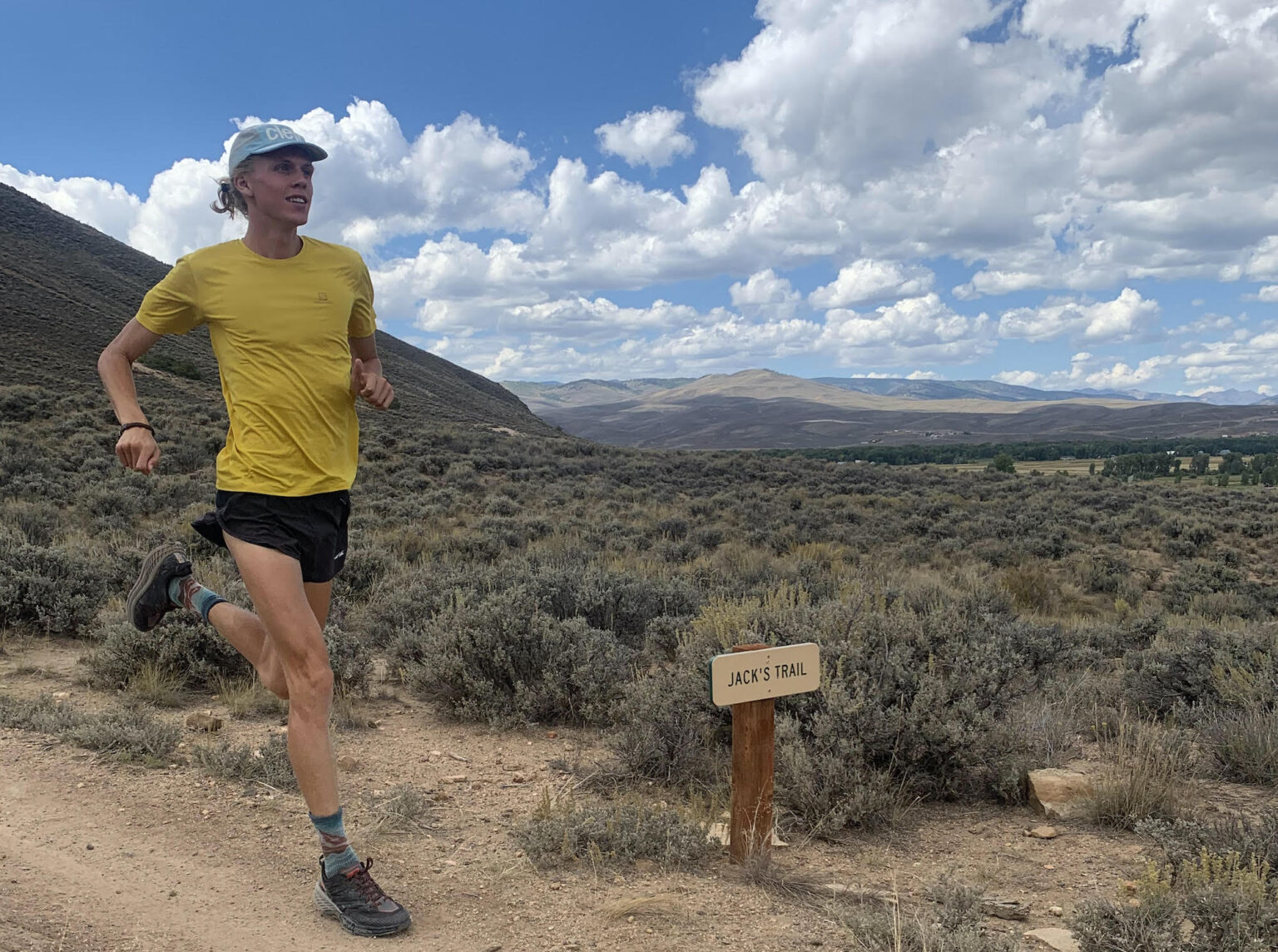Hoka One One Speedgoat 4
Test Locations: Gunnison — Crested Butte & Colorado Springs, Colorado
Test Duration: 500 miles
Stated Stack Height: 32 mm (Heel) / 28 mm (Forefoot)
Stated Heel-to-Toe Drop: 4 mm
Stated Features:
- Updated “Stepped” Lug Design
- Wider Toe-Box
- New lightweight Midsole Material
- Thinner gusseted tongue
Reviewer: 6’1″, 143 lbs / 185 cm, 65 kg
MSRP: $145
Size Tested: Men’s US 11
Stated Weight: 306 g / 10.8 oz
Blister Measured Weight (US Men’s 11):
- Shoes + Laces: 304 g (Left) & 311 g (Right)
- Insoles: 29 g (Left) & 28 g (Right)
- Total: 333 g (Left) & 339 g (Right)
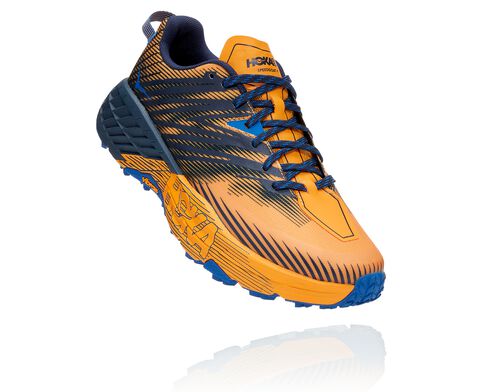
Intro
The Hoka One One Speedgoat is one of those iconic trail shoes that you’re almost guaranteed to see at any trail race. Cushioned, burly, and unmistakably Hoka, the Speedgoat has been a favorite shoe for trail runners across a wide range of distances and types of terrain.
Now on it’s 4th iteration, the Speedgoat has come a long way from the first model, while still staying true to its original intended purpose. I hadn’t ever run in previous versions of the Speedgoat — they always struck me as being too narrow and way too cumbersome for anything but smooth trails — but I can safely say that I am glad to have spent some time in the Speedgoat 4. After just over 500 miles in the shoe, I have some thoughts about where it really excels and where I found myself reaching for some other options.
Hoka One One Speedgoat 4 vs. Speedgoat 3
While I never ran in the previous version of the Speedgoat, I did train almost every day with someone who did, and therefore saw / heard a lot about where that version really shined. Overall, the updates to version 4 are small and purposeful. The upper is made from a thinner, stiffer mesh, the lugs are “stepped” which helps to provide a little more traction, and the fit through the forefoot is just a touch wider. Some people have also reported that the Speedgoat 4 feels a little bit firmer underfoot than its predecessor. It is also the first Speedgoat to be offered in a wide fit, which certainly opens it up as an option to people who could have never dreamed of cramming their feet into previous versions of the Speedgoat.
Fit
As with every product we review, we always suggest that you try a product on before buying it, to see how it fits with your individual preferences. With that said, I can provide some insight on how the Speedgoat 4 fits my foot. For reference, I have relatively low-volume feet with medium-high arches, and I do prefer to have a little bit more room in the toe box of my shoes.
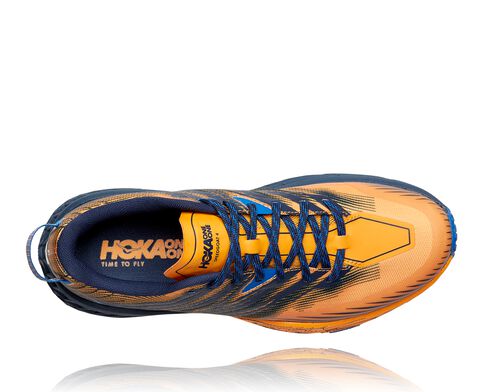
Out of the box the Speedgoat 4 is a very stiff shoe that definitely takes a couple runs to break in. For the first week or so, the upper would give me some blisters on the top of my second toe on my left foot. I initially thought that the shoe just wasn’t going to fit my foot, but after about a week the problem was completely resolved — which I attribute to the somewhat rigid-feeling upper breaking in over the first few days.
I found the fit of the Speedgoat 4 to be surprisingly secure on technical trails (more on that later) while still providing a surprising amount of room in the toe box. It is worth noting that if you are someone who typically runs in a brand like Altra and you need that wider toe-box, the Speedgoat 4 is likely going to feel too narrow. The Speedgoat 4 is by no means a wide shoe (think Salomon Sense Ride series), it just has a wider toe box than previous versions. Aside from that initial blistering from the upper, I had no other issues with blistering or hot spots in the nearly 500 miles that I spent in the Speedgoat 4.
Weight
With a stated weight of 306 grams, the Speedgoat 4 is fairly light for a shoe of its size / stack height, which is a common theme across Hoka’s lineup. For reference, below I have listed the weights of some comparable options in the max-cushion trail shoe market (All stated weights are based on a US Men’s size 9):
290 g / 10.2 oz — La Sportiva Karacal
292 g / 10.3 oz — Hoka One One Evo Mafate 2
306 g / 10.8 oz — Hoka One One Speedgoat 4
310 g / 10.9 oz — Dynafit Ultra 100
329 g / 11.6 oz — Altra Olympus 4
The Speedgoat 4 isn’t an incredibly light shoe, nor is that the purpose (you’ve got the Evo Speedgoat for that!). But it does come in around the middle of the pack when compared with a lot of other similar options on the market. That said, the Speedgoat does feel a bit softer than shoes on either side of the weight rankings, like the Evo Mafate and the Altra Olympus 4. In my time in the Speedgoat, I never found it to be overly heavy, and I ultimately ran a lot of longer interval workouts in the shoe because of this.
Upper
The upper of the Speedgoat 4 is updated from previous versions and very reminiscent of the MATRYX Kevlar reinforced uppers found in shoes like the Hoka Evo Mafate 2 and the Evo Speedgoat. I found the Speedgoat 4’s upper to be pretty stiff out of the box, with a break-in period of around 15-20 miles. The flipside of this stiffness is an upper that is very durable. At over 500 miles in the shoe I have yet to poke a hole through the upper with my left big toe, something I do in almost every other pair of shoes.
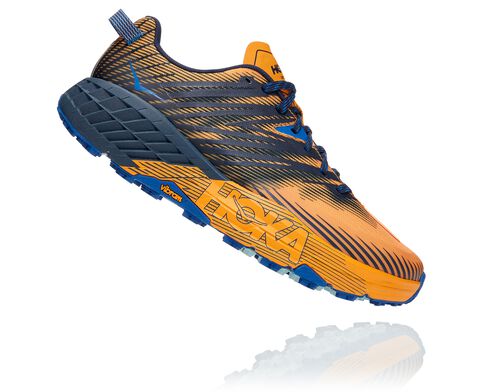
The thin, durable upper is a departure from Speedgoats past, which generally featured more plush uppers. This gives the Speedgoat 4 a distinctly more stripped-back feel, while still being one of the most comfortable trail running shoes on the market in terms of fit and cushion (at least in my opinion). The thin upper is also very breathable and I never found the shoes to be too hot. The upper mesh drains well and is also very quick drying, making it a great option for wet runs.
Midsole
The good stuff. The Speedgoat 4 features a high stack height of soft foam —32 mm in the heel and 28 mm in the forefoot, to be exact. The Speedgoat 4’s midsole compound is updated from previous versions of the Speedgoat, so long-time Speedgoat fans may notice that this shoe feels just slightly firmer and less mushy than the previous iterations. If you are new to the Speedgoat world (like me) you are more likely to be blown away by the softness of this midsole. That is to say, while the shoe is slightly firmer, it is still a true Speedgoat, with all the soft cushion that that entails.
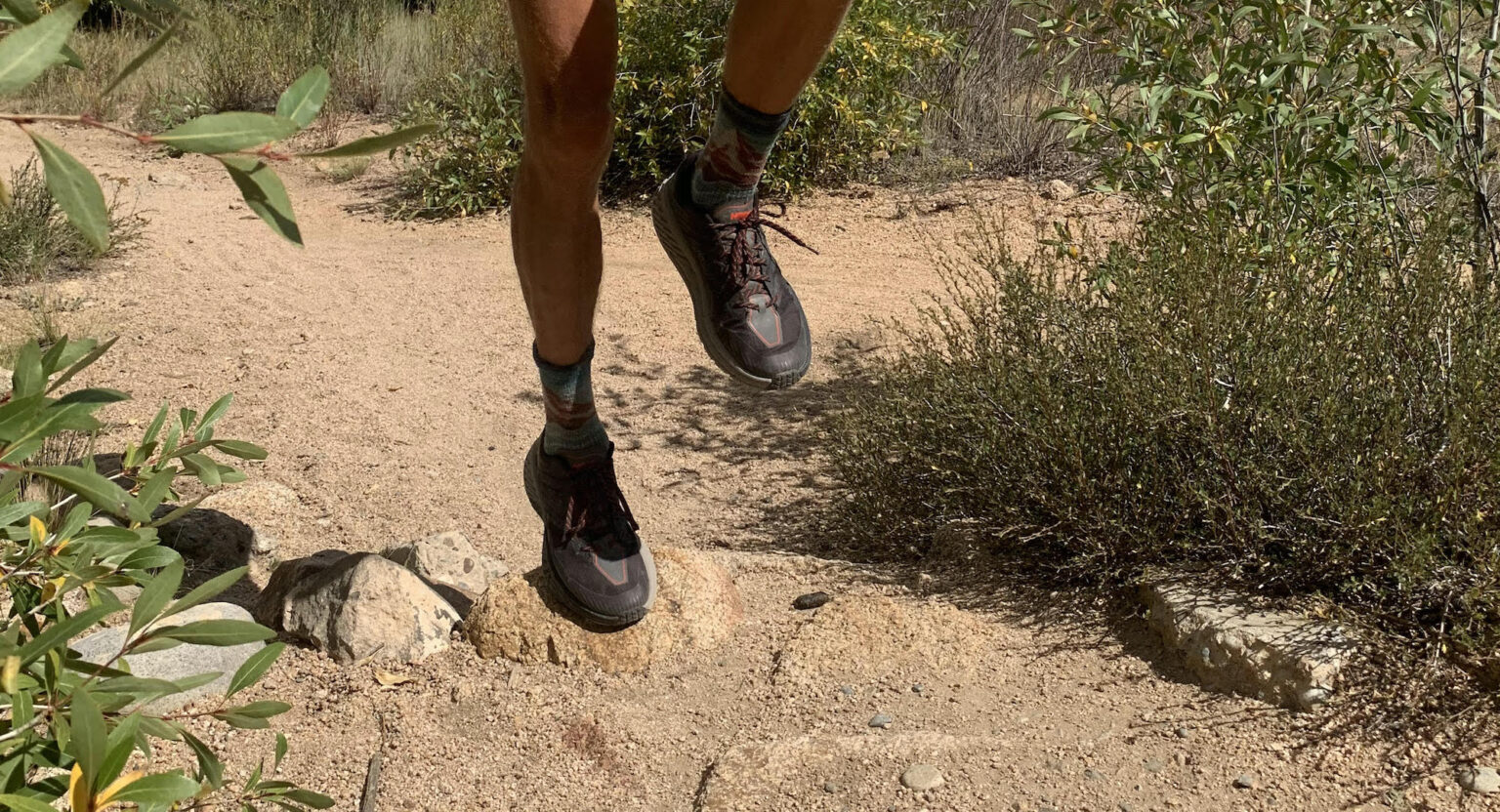
Outsole
The Speedgoat 4 features a small update to the Vibram Megagrip outsole found on the previous version of the shoe. The 5mm lugs on the Speedgoat 4 are “stepped,” which essentially just adds a bit more surface area to each lug. Having never run in the Speedgoat 3 I can’t speak to how much the stepped lugs actually improve the Speedgoat 4’s traction, but I can safely say that I was impressed by the shoe’s outsole overall. In my opinion, this is an area where the Speedgoat 4 really distances itself from some other maximalist trail shoes like the Altra Olympus 4.

On Trail
Over 500+ miles, I’ve used the Speedgoat 4 for a variety of different terrain, speeds, and distances. A bit to my surprise, it quickly became my go-to shoe for the majority of my runs. The relatively light weight, soft and rockered midsole, aggressive Vibram outsole, and precise fit made the Speedgoat 4 a compelling choice for all kinds of training. I have a ridiculously large quiver of shoes, and in general, I enjoy having a specialized tool for a specialized job. The Speedgoat 4 is one of the first true quiver killers I’ve run in since I was a high school track athlete (shout out to the Brooks Ghost 8). In the nearly 1000 miles that I spent between two pairs, I found that the Speedgoat 4 was so solid on such a wide array of runs that I hardly ran in anything else.
With that said, it isn’t necessarily the ideal shoe for everyone. The toe box, though widened in this iteration, is still nothing like the “Foot-Shape” toe box found in a shoe like the Altra Olympus. I also found that the Speedgoat 4’s high stack height and somewhat stiff midsole led to some occasional numbness in both feet, particularly on longer runs. I think this may be a result of a lack of ground feel while running in the shoe, which doesn’t come as much of a surprise for a shoe with such a high stack height. Still, the Speedgoat 4 will probably feel pretty over-cushioned if you prefer to feel the terrain you’re running over.
While the Speedgoat 4 did perform better than I expected in technical terrain, it still wouldn’t be my first choice for runs on really steep, really technical runs, simply because of its high stack-height. That said, the Speedgoat 4 is one of the more versatile shoes that I think I have ever run in, able to stand up to a wide variety of terrain and distances all in an incredibly comfortable package.
Durability
Durability is another area in which the Speedgoat 4 receives high marks from me. I took my first pair to over 500 miles and could have probably run it through another 100-200 miles had I really needed to. The outsole held up remarkably well considering how sticky the Vibram MegaGrip rubber is. At 500 miles the lugs are maybe one third of their initial height. The upper also shows very little sign of wear, which I attribute to the stiff mesh material that Hoka uses in this shoe. At 500 miles, the midsole has packed down a bit, but still retains a fair amount of comfort. So in my opinion, the Speedgoat 4 is probably one of the better shoes on the market in terms of miles-per-dollar.
Who’s It For?
In my opinion, the Speedgoat 4 is a great shoe for a wide variety of runners, trom the beginner who is looking for comfort as they build up to their first trail race, to the seasoned veteran looking to knock out their next big training block. The combination of relatively low weight, comfort, grip, and durability provided by this shoe makes it a great option as a daily trainer. For those who spend most of their time on steep, technical trails, or who prefer a really nimble shoe with a lot of ground-feel, the Speedgoat 4 is probably not the best option. It is, after all, a maximalist trail shoe geared towards ultramarathon racing and training. And those with a wider foot, or those who prefer a wide toe-box in their trail shoes, should consider looking at something like the Altra Olympus 4 (or the “wide” version of the Speedgoat 4).
Bottom Line
The Hoka One One Speedgoat 4 is a versatile, comfortable, and durable shoe that lives up to its heritage. It is the first Speedgoat to come in a wide fit option, opening the shoe up to lots of people who have given up on trying to cram their feet into a Hoka trail shoe. While the Speedgoat 4 is not my first choice for faster, steeper runs, I’ve thoroughly enjoyed my time in the shoe and found myself reaching for it more often than not on my way out the door. If you are looking for a comfortable, light, maximalist trail shoe to hammer out the miles, the Speedgoat 4 is certainly worth a look.

